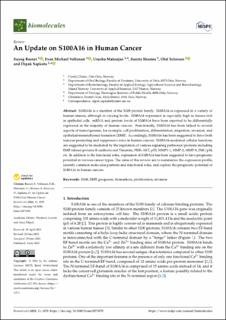| dc.contributor.author | Basnet, Suyog | |
| dc.contributor.author | Vallenari, Evan Michael | |
| dc.contributor.author | Maharjan, Urusha | |
| dc.contributor.author | Sharma, Sunita | |
| dc.contributor.author | Schreurs, Olaf Joseph Franciscus | |
| dc.contributor.author | Sapkota, Dipak | |
| dc.date.accessioned | 2024-02-23T08:14:26Z | |
| dc.date.available | 2024-02-23T08:14:26Z | |
| dc.date.created | 2023-07-08T15:41:18Z | |
| dc.date.issued | 2023 | |
| dc.identifier.issn | 2218-273X | |
| dc.identifier.uri | https://hdl.handle.net/11250/3119515 | |
| dc.description.abstract | S100A16 is a member of the S100 protein family. S100A16 is expressed in a variety of human tissues, although at varying levels. S100A16 expression is especially high in tissues rich in epithelial cells. mRNA and protein levels of S100A16 have been reported to be differentially expressed in the majority of human cancers. Functionally, S100A16 has been linked to several aspects of tumorigenesis, for example, cell proliferation, differentiation, migration, invasion, and epithelial-mesenchymal transition (EMT). Accordingly, S100A16 has been suggested to have both tumour-promoting and suppressive roles in human cancers. S100A16-mediated cellular functions are suggested to be mediated by the regulation of various signaling pathways/proteins including EMT-related proteins E-cadherin and Vimentin, PI3K-AKT, p53, MMP1-1, MMP-2, MMP-9, JNK/p38, etc. In addition to the functional roles, expression of S100A16 has been suggested to have prognostic potential in various cancer types. The aims of this review are to summarise the expression profile, identify common molecular partners and functional roles, and explore the prognostic potential of S100A16 in human cancers. | en_US |
| dc.language.iso | eng | en_US |
| dc.rights | Navngivelse 4.0 Internasjonal | * |
| dc.rights.uri | http://creativecommons.org/licenses/by/4.0/deed.no | * |
| dc.subject | S100 | en_US |
| dc.subject | EMT | en_US |
| dc.subject | prognosis | en_US |
| dc.subject | biomarkers | en_US |
| dc.subject | proliferation | en_US |
| dc.subject | invasion | en_US |
| dc.title | An Update on S100A16 in Human Cancer | en_US |
| dc.title.alternative | An Update on S100A16 in Human Cancer | en_US |
| dc.type | Peer reviewed | en_US |
| dc.type | Journal article | en_US |
| dc.description.version | publishedVersion | en_US |
| dc.rights.holder | Copyright: © 2023 by the authors. Licensee MDPI, Basel, Switzerland. | en_US |
| dc.subject.nsi | VDP::Medisinske Fag: 700::Basale medisinske, odontologiske og veterinærmedisinske fag: 710::Medisinsk molekylærbiologi: 711 | en_US |
| dc.source.volume | 13 | en_US |
| dc.source.journal | Biomolecules | en_US |
| dc.source.issue | 7 | en_US |
| dc.identifier.doi | https://doi.org/10.3390/biom13071070 | |
| dc.identifier.cristin | 2161527 | |
| dc.source.articlenumber | 1070 | en_US |
| cristin.ispublished | true | |
| cristin.fulltext | original | |
| cristin.qualitycode | 1 | |

